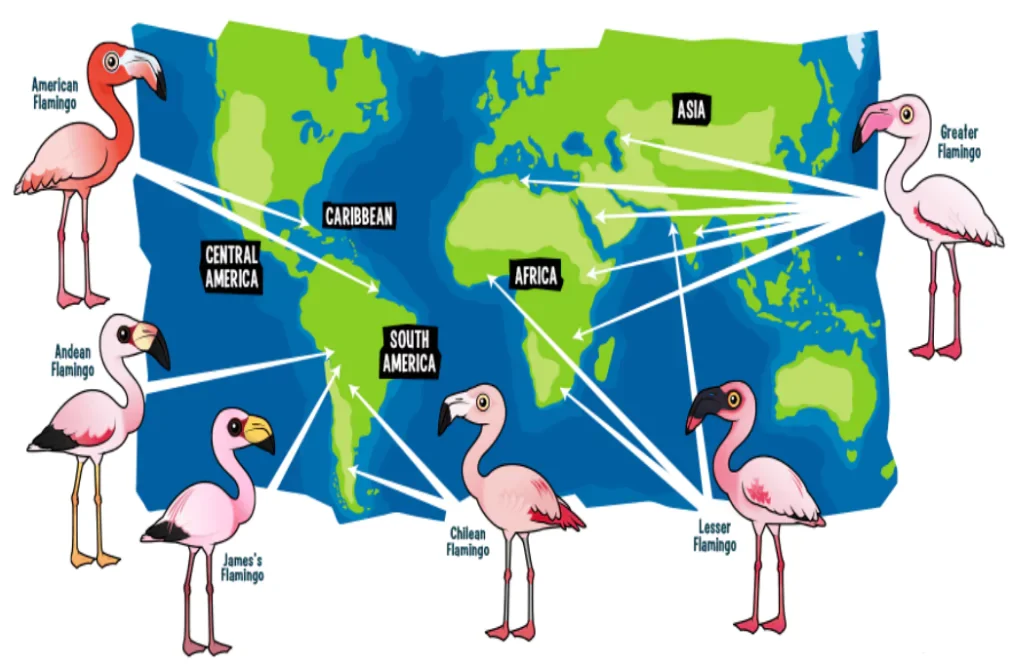The much-awaited Flamingo Festival 2025′ will be conducted at Sullurpeta in Tirupati district of Andhra Pradesh from January 18 to 20.

- More than 200 varieties of birds are expected to fly to this region during this season.
- Nelapattu Bird Sanctuary is flocked by grey pelicans, spoonbill storks, cormorants, open bill storks and others from the Southeast Asian region during this season.
About Flamingo Distribution
- It is found in tropical and subtropical areas.
- In India, 2 species of flamingos are found. These are Greater flamingo and Lesser flamingo.
Enroll now for UPSC Online Classes
Details about different Flamingo species, their conservation status and features
| Species |
Distribution |
IUCN Status |
Distinctive Features |
| Greater Flamingo (Phoenicopterus roseus) |
Africa, Europe, and Asia (India) |
Least Concern
CITES → Appendix II |
Largest flamingo species, pale pink plumage |
| Chilean Flamingo (Phoenicopterus chilensis) |
South America |
Near Threatened |
Similar to Greater Flamingo but with a darker pink hue |
| American or Caribbean Flamingo (Phoenicopterus ruber) |
Caribbean, South America, and Florida |
Near Threatened |
Bright pink plumage, long, slender neck |
| Lesser Flamingo (Phoeniconaias minor) |
Africa and India |
Near Threatened
CITES → Appendix II |
Smallest flamingo species, bright pink plumage |
| Andean Flamingo (Phoenicoparrus andinus) |
Andes Mountains in South America |
Vulnerable |
Yellow legs and feet, red spot between nostrils |
| James’s or Puna Flamingo (Phoenicoparrus jamesi) |
Andes Mountains in South America |
Near Threatened |
All-black flight feathers, unique bill shape |
Check Out UPSC NCERT Textbooks From PW Store
Nelapattu Bird Sanctuary
Introduction
- Named after the village – ‘Nelapattu’, located just adjoining in the Sanctuary in Nellore district of Andhra Pradesh is this wetland mainly for migratory water birds.
- The farmers of Nelapattu and their bird visitors have a symbiotic relationship.
- The bird ‘Guano’ (waste matter) acts as a natural fertilizer to the crops and the villagers in turn protect the birds.
Uniqueness
- The largest breeding ground for the Grey pelicans in South East Asia, with approximately 1,500 pelicans breeding every year.
- The local people of Nelapattu, Muchalagunta, Mylangam, etc; protect the birds as “celestial birds”, as their arrival brings good rains and good crops.
Forest Type
- Southern Dry Evergreen Scrub, Barringtonia swamp forests, Grassland and wetland.
Flora
- Plants like Buchnania angustifolia, barringtonia actutangula, Acacia arabica, Albizzia amara, Borassus flabellifer, Euphorbia antiquorum, etc; are a few of the dominant species in this wetland Sanctuary.
Fauna
- Scorpion fish, Cat fish, Fresh water silark; etc; account for the amazing fish fauna.
- The birds also feed on prawns found in the water.
- Spot billed pelican, Grey frigate bids, Black bittern, Lesser whistling teal, Black capped kingfisher, Whimbrel, Painted snipe, Spotted sand piper, Gull billed tern, Orange breasted green pigeon, Indian pitta, Loten’s sunbird, Ashy minivet, Shama, etc; are to name a few.
- The mammalian life is represented by Jackal, Black napped hare, Jungle cat, etc.
|
![]() 10 Jan 2025
10 Jan 2025



